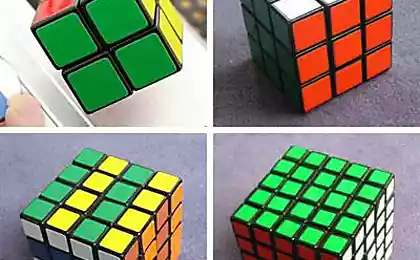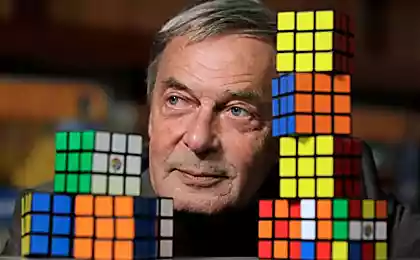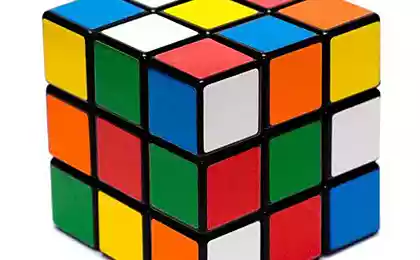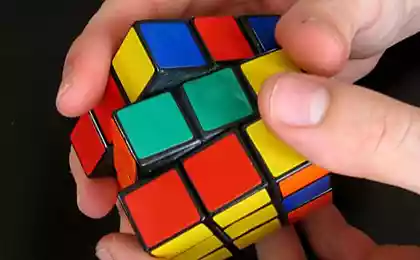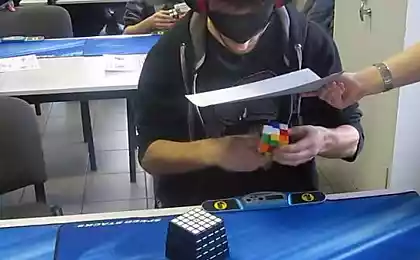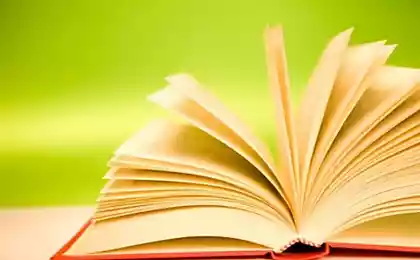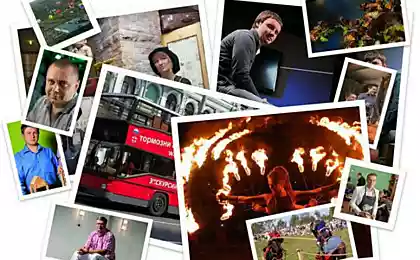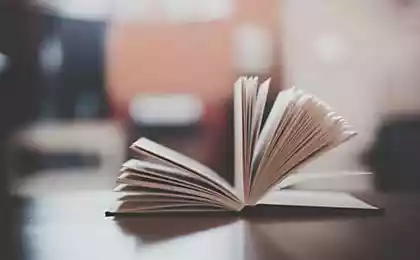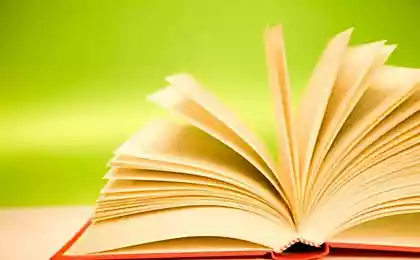2720
History of Rubik's Cube
In 1974, 30-year-old Erno Rubik (Erno Rubik), in the future, the first official millionaire Eastern European Socialist. Block, worked at the Faculty of Interior Design (Department of Interior Design) of the Budapest Academy of Applied Arts and Crafts (Academy of Applied Arts and Crafts).
He taught Hungarian students of industrial design and architecture. Also fond of geometry and three-dimensional modeling of subject, finding it an ideal tool for the development of students' skills in spatial imagination. As is usually the case with outstanding inventions project cube nurtured for years. At the beginning of the invention is a set of 27 wooden cubes with colored faces (ie a total of 27 x 6 = 156 colored faces).
According to one version, with the help of this tutorial Rubik tried to explain to pupils dull basics of mathematical group theory. The task of the inventor was: get some multicolored cubes rotate freely in their seats without disturbing structural unity of all devices.
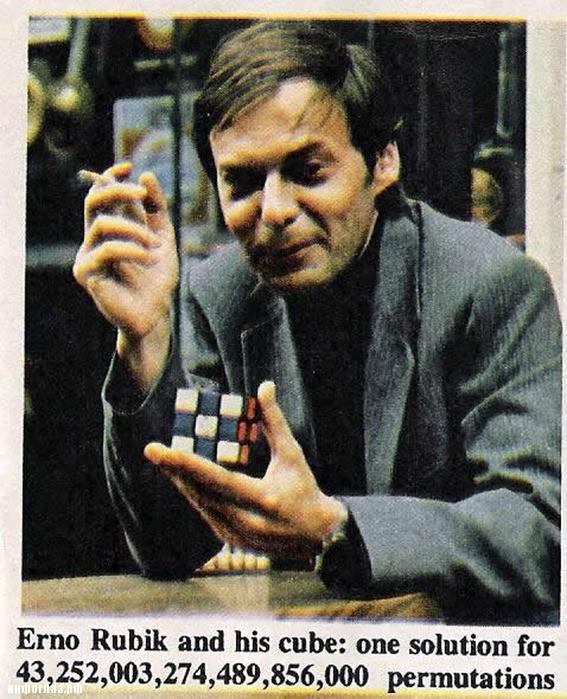
In the future, it was necessary to discard all unnecessary: in his first Rubik's Cube has left only 54 external faces: one color in six central cubes, two-color side at twelve, and the tricolor at the eight corners. Exactly in this way we see the Rubik's cube now. The vacant seat only "internal" cube was placed cylindrical fastening mechanism, which was strongly associated with all the outer cubes, but allow them to rotate freely relative to each other. So out of a textbook, a Rubik's Cube became a toy!
As pervoispytateley puzzle Rubik were friends and students of the Academy of jurisdiction. Since the idea of free enterprise in the former Soviet bloc understand then conventionally enough, desire patented design it occurred to Rubik only after some time.
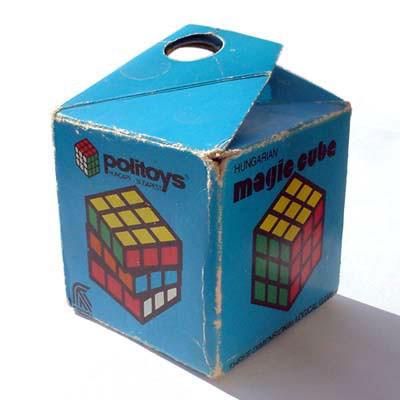
In 1975 the Hungarian Rubik received a patent for his invention. However, the release of an experimental batch of industrial blocks took place only at the end of 1977. The first was a small cube manufacturer Budapest society that issued the cube as Christmas Toys for Christmas 1978. It was solidly made under the name "Magic Cube» (Buvuos Kocka) in colorful packaging, single copies of which have appeared in the USSR. Until World triumph in the history of the best-selling puzzle in his hands every eight inhabitants, Rubic cube was still very, very far away. The fact that products from the end of 1977 in Hungary, limited edition Rubik's Cube is not immediately won the West.
It is possible that the event would further develop a snail's pace, if a toy is not interested in someone Lakz Tibor (Tibor Laczi) - German computer businessman of Hungarian origin, who accidentally saw a Rubik's Cube during regular business trip to Hungary. Tibor went for coffee and noticed the puzzle in the hands of the waiter cafe. Fond of mathematics Lakz came in admiration of toys and started to promote it with Tom Kremer - successful games inventor and founder of Seven Towns Ltd.
The present "cubic" invasion began only in 1980, when as a result of joint efforts of Tom Kremer and Tibor Lakz, a license to manufacture the cube-Rubik bought by Ideal Toy Corporation (namely she gave puzzle name Rubik's Cube), which placed an order for one million units . then start to promote and sell this toy in the world. At the time it was released about 100 million "legal cubes" and even more - fakes. In the 80s through the cube was probably one in ten of the civilized world. In the west, a Rubik's Cube appeared in May 1980, and in the USSR Kubik came "the masses" in 1981. According to some, the right to issue toys cost the USSR inconceivable for the Soviet man worth 3 million dollars. The first force puzzle felt the teacher - whole classes purposefully, not leaving for change, fiercely twirled cubes. Students collect it during lessons under desks. Teachers taking it during the lessons themselves creaked Dice in the classroom, students cut off from classy magazine. And then sat up late in the teachers trying to assemble the puzzle. The schools were "closed" championships at speed - is a legendary personality, which could in the early years of "cubist" build it in one minute (at the very Rubik's the first time at the assembly took a whole month).
Lucky having a real dice in the early '80s, it was not much, - someone brought to school and Rubik him a queue to touch the puzzle, hold in their hands. Meaningful opportunity to collect it, at first glance, seem quite incredible. For those with the Rubik's Cube was not, in 1982 the magazine "Young technician" published an article with illustrations and drawings titled Everyone cube cubes on how to make it yourself. Soon timid critical notes on mania "Cubism" at the request of the workers were replaced by numerous publications, "What should I do to still collect Kubik?" In those days it looked very interesting: in the magazine "Science and Life" next to the story of mineral fertilizers and Soviet space achievements great article - "How to assemble a Rubik's Cube." Perhaps someone reading this will still remembers circuit assembly according to the method of the magazine "Science and Life", consisting of a kind of spells F2V-1L2.
As he wrote in his journal article "Spark", Rubik's Cube opened a passage to the Soviet people in virtual reality, although this phrase in the lexicon of the Soviet people did not yet exist. A virtual reality, as it turns out, was a very even. Kubik appeared dense foods, one toy successfully replace: two congresses leading and guiding one Ice Hockey World Championships, two hundred and fifty grams of vodka without snacks, monthly norm of nonfat yogurt and half of the New Year feast. The ranking presents the dice as far superior to the book, and traditionally the best gift and the source of knowledge. Kubik twisted selflessly, aloof, right in the subway, on the tram, in design offices, in sanatoriums, rest homes, in bed. And how many people have left in the bout, and not being able to cope with the invention insidious Hungary? Cubes often died - of anger desperate collectors threw them against the wall, pressed down. In normal (in the sense of intelligent) then the family was supposed to have no less than two blocks at the same time - so no one had to wait with envy looking at collecting. Kubik was the best gift that you can give for all occasions: birthday, wedding, housewarming, new year.

Rumor has it that the famous British scientists - this time psychologists - gave the puzzle apes. Chimpanzees initially with extreme interest the her, but then began to worry, anxiety turned into intense excitement comparable to despair. One of the monkeys threw the dice away from the cells, others are trying to eat him, and the third in malice is broken down into small pieces. If only monkeys! .. According to the observations of these academics and their fellow neurologists, some people more than an hour to no avail wheeled toy in his hands, began to get nervous, mad, people, too unbalanced, becomes aggressive, they have a desire to break the cube. Just do not know, but like, to services such expansive people have been released for sale small plastic axes, designed for the "punishment" of the Shrew toys. By purchasing the enclosed instructions, which stated that you can make parts of a broken cube.
In 1982 in Budapest held the world championship on collecting Rubik's Cube. It was attended by representatives from 19 countries - the winners in the national championships. For solutions offered three jobs. The best time is counted from three attempts. Each contestant gets a new cube by "Politoys." All cubes were equally difficult tangled 25-30 rotations by computer. The computer is programmed as a random number generator and unknown beforehand determines rotatable face of the cube, the direction and angle of rotation. Before the start of countdown, each contestant was given 15 seconds to study the original coloring dice and selecting solutions. From the contestants were required to collect the dice no more than 60 seconds. The best time of the assembly - 22, 95 seconds showed the 16-year-old student from Los Angeles Minh Thai, and one of the contenders for victory in a rush broke two dice in a row and was disqualified. Although legends about unknown geeks who collected cube almost 10 seconds. Ironically, the first world championship coincided with the peak of popularity cubes. Soon a wave of universal excitement begins to subside, and the hundreds of millions of cubes popryachutsya the dusty corners. But this is still a few years.
Record collecting Rubik's Cube in the past years has repeatedly passed from hand to hand and today is virtually unattainable for the average person time: less than 8 seconds (average of 5 attempts !!!!). The current record is recorded on the website WCA. Interestingly, many of Coober manage to collect a cube less than 30 rotating faces (Rubik's Cube: Fewest moves), but mathematicians are convinced that the day will come when the dice will be defeated by no more than 22 movements from any initial position, not only in the case of rare Good luck!
No problems with the sale of the puzzle was not, there were problems with the production. Hungary physically unable to do more than a few million units per year. Factories for the manufacture of bricks opened in Hong Kong, Taiwan, Costa Rica and Brazil.
Passion for the toy had no linguistic, social and age boundaries. Respectable matrons and managers of banks, baseball players and pilots, librarians and attendants at parking wheeled cube all day. Many restaurants cube was one of the compulsory subjects along with tableware salt and pepper shakers. From many hours of continuous play at people simply drove wrist.
At the forefront of the worldwide movement was a youth, school and college students. The complexity of the cube assembly gave rise to a stream of special editions on the problem: it was released more than 60 books. Do not lag behind the Soviet magazine "Science and Life", for a few years in each room, pay attention to the Rubik's cube.
Already in 1980, the Hungarian national cube gets the prize for the best invention and wins competitions for the best toys in the United States, Britain, France and Germany. In 1981, the cube falls in the exposure of the New York Museum of Modern Art (MOMA). In the same year, a limited edition in England goes

Royal Puzzle - Rubik's Cube version dedicated to the wedding of Prince Charles and Lady Diana, held on 29 July 1981.
Meanwhile, the decline of interest in multi-colored tempter was not at all in harmony and universal. So it might seem a toy manufacturers, in the wake of the gambling craze nashtampovat tens of millions of "extra" cubes and a year or two have forgotten that the market is still limited. And maybe to blame the whole mass sad sack, and were not able to collect the Cube? Or the logic of spatial rotations overshadowed political debates, parties and demonstrations? Or just came electronic era, and the people went away to play "Tetris»?
In any case, the result was a collapse in sales, huge stocks of unsold blocks in factories and shops, as well as the lack of new manufacturing orders. Therefore, since 1983, it became increasingly difficult for the cube, and then did not find on the counter.
However, the man who has spearheaded the economic miracle Rubik's Cube, Tom Kremer, kept faith in the everlasting light potential puzzle. Kremer believed it like "Monopoly" or Scrabble, the game at all times. Using a comfortable situation, in 1985 the British firm Seven Towns belonging Kremer outbids right to die and by 1991 very carefully and selectively starts again slowly release it to the market. Triumphant return of the "Toy №1" began in 1996, when the efforts of all of the same Tom Kremer in the US has sold 300 thousand. Cubes, and a year later in the UK - 100 thousand.
In the photo: Tom Kremer and Erno Rubik, 2007
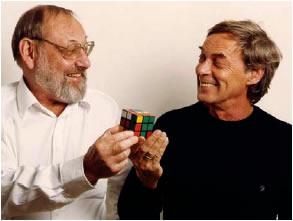
It is worth noting that in the 90 years Cube has found a second wind - with the advent of personal computers appeared and virtual Rubik's Cube for Windows. In the cube has become possible to play on the computer. However, the living, tangible, branded creaking Rubik's cube, even today, is still a rarity! Perhaps in this, despite the fact that the younger generation prefers electronic games, nowadays the Rubik's Cube again becomes best-Celler in many countries.
In 2013 Rubik's Cube Rubik's presented an updated, revolutionary difference which was the lack of stickers - they have been replaced by a more practical and beautiful plastic inserts. With this mechanism has been updated and puzzles (the first time in many decades !!), which received a spherical core, a special type of plastic that provides a smooth glide and soft corners.
With regard to the inventor, it is a partial 40 years, becoming a millionaire, rich private citizen of Hungary and a legend, traveled the world, quickly tired of the public attention and went off into the shadows to quietly do their own experiments and inventions in which he founded Rubik's Studio. Appeared so famous Rubik's Snake - the development of ancient Chinese geometric puzzle "Tangram", also had a resounding success, but the popularity of the unforgettable dice even more than her away.
Now Enre Rubik lives in a suburb of Budapest, occasionally speaking with meaningful and quasi-religious statements to the press, one of which is shown in italics at the beginning of the page immediately under the photo of the author. Every year, many fans and collectors of puzzles to celebrate the birthday's Cube - 13 July 1944.
In 1988, Erno Rubik's Cube founded the International Fund to support young inventors. Since 1990, the Rubik - Chairman of the Hungarian Academy of Engineering, 1996 - its honorary chairman. In 1983 he was awarded the State Prize of Hungary, and in 1995 - Prize of. Dennis Gabor for creativity and innovative activities. Now Rubik interested in computers and look for opportunities that will change the relationship between computer and user.
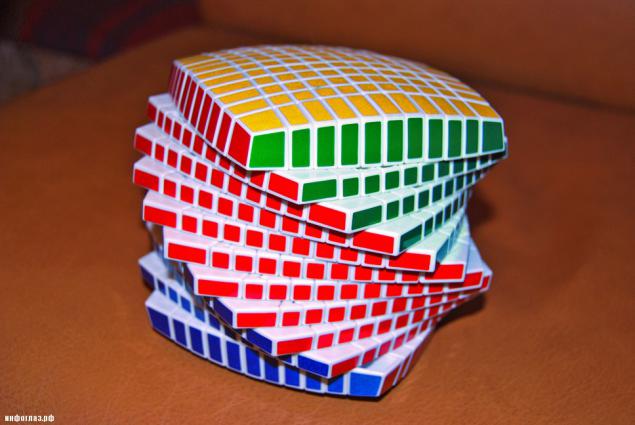
Rubik's Cube: just the facts
43, 252, 003, 274, 489, 856, 000 possible combinations, and only one correct solution.
Over 350 million Rubik's cubes sold worldwide. If you add them to the number 1, the band of the Rubik's cube could be put to the North Pole to the South Pole.
Invented by a professor of architecture and design Erno Rubik in 1974 in Budapest as a textbook on geometry, and not exported from Hungary until 1980.
The original name given to the inventor - "Magic Cube". The puzzle was renamed the Rubik's Cube after the presentation on the oldest toy fair in Nuremberg in 1980 and the subsequent million orders for the US.
At the height of popularity in 1980, twisted puzzle every fifth inhabitant of the earth!
The size of the part of the original Rubik's Cube - 57mm. This is the "gold standard" toys, Erno Rubik calculated and still observe brand Rubik's.
Hundreds of thousands of video clips on a puzzle on YouTube
The first World Championship in Rubik's cube went to Hungary in 1982 and was won by a student from Los Angeles named Ming Tai (Minh Thai), who collected a Rubik's cube for 22 95sek. Competitions are held in several categories: assembly with one hand, legs, eyes closed, and even under water in one breath.
It is believed that the longest assembled his Rubik's Cube Briton Graham Parker who received it as a gift on his 19th birthday and finally get it together for the first time as recently as 47 years of age, ie, after 26 years!
Number of combinations of the Rubik's Cube (mathematics).

The number of different possible states of the Rubik cube equals (8! X 38-1) x (12! X 212-1) / 2 = 43 252 003 274 489 856 000, i.e. more than 43 quintillion combinations. Despite that, theoretically, any state of the puzzle can be assembled in 22 moves - the so-called "algorithm of the Lord." The task of finding the optimal (in the number of moves) algorithm is the most difficult and yet unsolved mathematical problems related to the Rubik's Cube.
First Cubes accompanied by the following annotation: "This toy develops logical thinking and stereoscopic vision in children and adults. Synchronous manipulation on many surfaces is a very complex task, which can be resolved only through the opening turns logic ».
All rights to any three-dimensional reproduction, and even on any graphics or screen representation of this object, Erno Rubik remain behind and will be relevant until the expiration of 70 years from the death of the creator of the brilliant masterpiece.
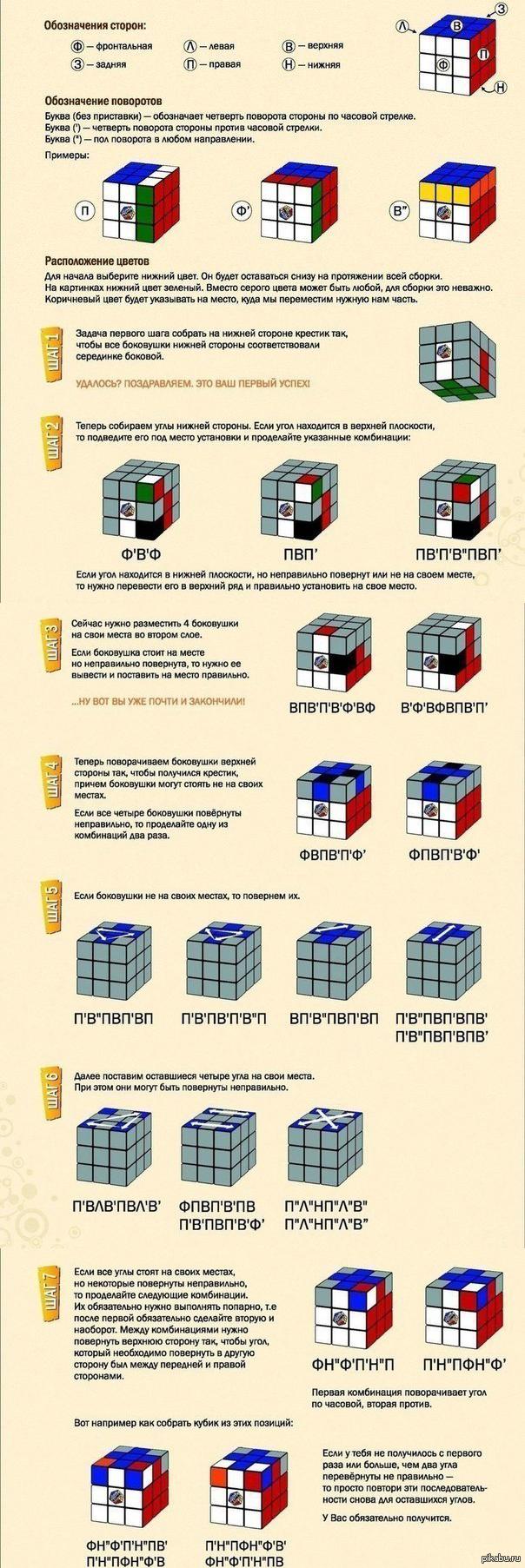
Source: http: //
He taught Hungarian students of industrial design and architecture. Also fond of geometry and three-dimensional modeling of subject, finding it an ideal tool for the development of students' skills in spatial imagination. As is usually the case with outstanding inventions project cube nurtured for years. At the beginning of the invention is a set of 27 wooden cubes with colored faces (ie a total of 27 x 6 = 156 colored faces).
According to one version, with the help of this tutorial Rubik tried to explain to pupils dull basics of mathematical group theory. The task of the inventor was: get some multicolored cubes rotate freely in their seats without disturbing structural unity of all devices.

In the future, it was necessary to discard all unnecessary: in his first Rubik's Cube has left only 54 external faces: one color in six central cubes, two-color side at twelve, and the tricolor at the eight corners. Exactly in this way we see the Rubik's cube now. The vacant seat only "internal" cube was placed cylindrical fastening mechanism, which was strongly associated with all the outer cubes, but allow them to rotate freely relative to each other. So out of a textbook, a Rubik's Cube became a toy!
As pervoispytateley puzzle Rubik were friends and students of the Academy of jurisdiction. Since the idea of free enterprise in the former Soviet bloc understand then conventionally enough, desire patented design it occurred to Rubik only after some time.

In 1975 the Hungarian Rubik received a patent for his invention. However, the release of an experimental batch of industrial blocks took place only at the end of 1977. The first was a small cube manufacturer Budapest society that issued the cube as Christmas Toys for Christmas 1978. It was solidly made under the name "Magic Cube» (Buvuos Kocka) in colorful packaging, single copies of which have appeared in the USSR. Until World triumph in the history of the best-selling puzzle in his hands every eight inhabitants, Rubic cube was still very, very far away. The fact that products from the end of 1977 in Hungary, limited edition Rubik's Cube is not immediately won the West.
It is possible that the event would further develop a snail's pace, if a toy is not interested in someone Lakz Tibor (Tibor Laczi) - German computer businessman of Hungarian origin, who accidentally saw a Rubik's Cube during regular business trip to Hungary. Tibor went for coffee and noticed the puzzle in the hands of the waiter cafe. Fond of mathematics Lakz came in admiration of toys and started to promote it with Tom Kremer - successful games inventor and founder of Seven Towns Ltd.
The present "cubic" invasion began only in 1980, when as a result of joint efforts of Tom Kremer and Tibor Lakz, a license to manufacture the cube-Rubik bought by Ideal Toy Corporation (namely she gave puzzle name Rubik's Cube), which placed an order for one million units . then start to promote and sell this toy in the world. At the time it was released about 100 million "legal cubes" and even more - fakes. In the 80s through the cube was probably one in ten of the civilized world. In the west, a Rubik's Cube appeared in May 1980, and in the USSR Kubik came "the masses" in 1981. According to some, the right to issue toys cost the USSR inconceivable for the Soviet man worth 3 million dollars. The first force puzzle felt the teacher - whole classes purposefully, not leaving for change, fiercely twirled cubes. Students collect it during lessons under desks. Teachers taking it during the lessons themselves creaked Dice in the classroom, students cut off from classy magazine. And then sat up late in the teachers trying to assemble the puzzle. The schools were "closed" championships at speed - is a legendary personality, which could in the early years of "cubist" build it in one minute (at the very Rubik's the first time at the assembly took a whole month).
Lucky having a real dice in the early '80s, it was not much, - someone brought to school and Rubik him a queue to touch the puzzle, hold in their hands. Meaningful opportunity to collect it, at first glance, seem quite incredible. For those with the Rubik's Cube was not, in 1982 the magazine "Young technician" published an article with illustrations and drawings titled Everyone cube cubes on how to make it yourself. Soon timid critical notes on mania "Cubism" at the request of the workers were replaced by numerous publications, "What should I do to still collect Kubik?" In those days it looked very interesting: in the magazine "Science and Life" next to the story of mineral fertilizers and Soviet space achievements great article - "How to assemble a Rubik's Cube." Perhaps someone reading this will still remembers circuit assembly according to the method of the magazine "Science and Life", consisting of a kind of spells F2V-1L2.
As he wrote in his journal article "Spark", Rubik's Cube opened a passage to the Soviet people in virtual reality, although this phrase in the lexicon of the Soviet people did not yet exist. A virtual reality, as it turns out, was a very even. Kubik appeared dense foods, one toy successfully replace: two congresses leading and guiding one Ice Hockey World Championships, two hundred and fifty grams of vodka without snacks, monthly norm of nonfat yogurt and half of the New Year feast. The ranking presents the dice as far superior to the book, and traditionally the best gift and the source of knowledge. Kubik twisted selflessly, aloof, right in the subway, on the tram, in design offices, in sanatoriums, rest homes, in bed. And how many people have left in the bout, and not being able to cope with the invention insidious Hungary? Cubes often died - of anger desperate collectors threw them against the wall, pressed down. In normal (in the sense of intelligent) then the family was supposed to have no less than two blocks at the same time - so no one had to wait with envy looking at collecting. Kubik was the best gift that you can give for all occasions: birthday, wedding, housewarming, new year.

Rumor has it that the famous British scientists - this time psychologists - gave the puzzle apes. Chimpanzees initially with extreme interest the her, but then began to worry, anxiety turned into intense excitement comparable to despair. One of the monkeys threw the dice away from the cells, others are trying to eat him, and the third in malice is broken down into small pieces. If only monkeys! .. According to the observations of these academics and their fellow neurologists, some people more than an hour to no avail wheeled toy in his hands, began to get nervous, mad, people, too unbalanced, becomes aggressive, they have a desire to break the cube. Just do not know, but like, to services such expansive people have been released for sale small plastic axes, designed for the "punishment" of the Shrew toys. By purchasing the enclosed instructions, which stated that you can make parts of a broken cube.
In 1982 in Budapest held the world championship on collecting Rubik's Cube. It was attended by representatives from 19 countries - the winners in the national championships. For solutions offered three jobs. The best time is counted from three attempts. Each contestant gets a new cube by "Politoys." All cubes were equally difficult tangled 25-30 rotations by computer. The computer is programmed as a random number generator and unknown beforehand determines rotatable face of the cube, the direction and angle of rotation. Before the start of countdown, each contestant was given 15 seconds to study the original coloring dice and selecting solutions. From the contestants were required to collect the dice no more than 60 seconds. The best time of the assembly - 22, 95 seconds showed the 16-year-old student from Los Angeles Minh Thai, and one of the contenders for victory in a rush broke two dice in a row and was disqualified. Although legends about unknown geeks who collected cube almost 10 seconds. Ironically, the first world championship coincided with the peak of popularity cubes. Soon a wave of universal excitement begins to subside, and the hundreds of millions of cubes popryachutsya the dusty corners. But this is still a few years.
Record collecting Rubik's Cube in the past years has repeatedly passed from hand to hand and today is virtually unattainable for the average person time: less than 8 seconds (average of 5 attempts !!!!). The current record is recorded on the website WCA. Interestingly, many of Coober manage to collect a cube less than 30 rotating faces (Rubik's Cube: Fewest moves), but mathematicians are convinced that the day will come when the dice will be defeated by no more than 22 movements from any initial position, not only in the case of rare Good luck!
No problems with the sale of the puzzle was not, there were problems with the production. Hungary physically unable to do more than a few million units per year. Factories for the manufacture of bricks opened in Hong Kong, Taiwan, Costa Rica and Brazil.
Passion for the toy had no linguistic, social and age boundaries. Respectable matrons and managers of banks, baseball players and pilots, librarians and attendants at parking wheeled cube all day. Many restaurants cube was one of the compulsory subjects along with tableware salt and pepper shakers. From many hours of continuous play at people simply drove wrist.
At the forefront of the worldwide movement was a youth, school and college students. The complexity of the cube assembly gave rise to a stream of special editions on the problem: it was released more than 60 books. Do not lag behind the Soviet magazine "Science and Life", for a few years in each room, pay attention to the Rubik's cube.
Already in 1980, the Hungarian national cube gets the prize for the best invention and wins competitions for the best toys in the United States, Britain, France and Germany. In 1981, the cube falls in the exposure of the New York Museum of Modern Art (MOMA). In the same year, a limited edition in England goes

Royal Puzzle - Rubik's Cube version dedicated to the wedding of Prince Charles and Lady Diana, held on 29 July 1981.
Meanwhile, the decline of interest in multi-colored tempter was not at all in harmony and universal. So it might seem a toy manufacturers, in the wake of the gambling craze nashtampovat tens of millions of "extra" cubes and a year or two have forgotten that the market is still limited. And maybe to blame the whole mass sad sack, and were not able to collect the Cube? Or the logic of spatial rotations overshadowed political debates, parties and demonstrations? Or just came electronic era, and the people went away to play "Tetris»?
In any case, the result was a collapse in sales, huge stocks of unsold blocks in factories and shops, as well as the lack of new manufacturing orders. Therefore, since 1983, it became increasingly difficult for the cube, and then did not find on the counter.
However, the man who has spearheaded the economic miracle Rubik's Cube, Tom Kremer, kept faith in the everlasting light potential puzzle. Kremer believed it like "Monopoly" or Scrabble, the game at all times. Using a comfortable situation, in 1985 the British firm Seven Towns belonging Kremer outbids right to die and by 1991 very carefully and selectively starts again slowly release it to the market. Triumphant return of the "Toy №1" began in 1996, when the efforts of all of the same Tom Kremer in the US has sold 300 thousand. Cubes, and a year later in the UK - 100 thousand.
In the photo: Tom Kremer and Erno Rubik, 2007

It is worth noting that in the 90 years Cube has found a second wind - with the advent of personal computers appeared and virtual Rubik's Cube for Windows. In the cube has become possible to play on the computer. However, the living, tangible, branded creaking Rubik's cube, even today, is still a rarity! Perhaps in this, despite the fact that the younger generation prefers electronic games, nowadays the Rubik's Cube again becomes best-Celler in many countries.
In 2013 Rubik's Cube Rubik's presented an updated, revolutionary difference which was the lack of stickers - they have been replaced by a more practical and beautiful plastic inserts. With this mechanism has been updated and puzzles (the first time in many decades !!), which received a spherical core, a special type of plastic that provides a smooth glide and soft corners.
With regard to the inventor, it is a partial 40 years, becoming a millionaire, rich private citizen of Hungary and a legend, traveled the world, quickly tired of the public attention and went off into the shadows to quietly do their own experiments and inventions in which he founded Rubik's Studio. Appeared so famous Rubik's Snake - the development of ancient Chinese geometric puzzle "Tangram", also had a resounding success, but the popularity of the unforgettable dice even more than her away.
Now Enre Rubik lives in a suburb of Budapest, occasionally speaking with meaningful and quasi-religious statements to the press, one of which is shown in italics at the beginning of the page immediately under the photo of the author. Every year, many fans and collectors of puzzles to celebrate the birthday's Cube - 13 July 1944.
In 1988, Erno Rubik's Cube founded the International Fund to support young inventors. Since 1990, the Rubik - Chairman of the Hungarian Academy of Engineering, 1996 - its honorary chairman. In 1983 he was awarded the State Prize of Hungary, and in 1995 - Prize of. Dennis Gabor for creativity and innovative activities. Now Rubik interested in computers and look for opportunities that will change the relationship between computer and user.

Rubik's Cube: just the facts
43, 252, 003, 274, 489, 856, 000 possible combinations, and only one correct solution.
Over 350 million Rubik's cubes sold worldwide. If you add them to the number 1, the band of the Rubik's cube could be put to the North Pole to the South Pole.
Invented by a professor of architecture and design Erno Rubik in 1974 in Budapest as a textbook on geometry, and not exported from Hungary until 1980.
The original name given to the inventor - "Magic Cube". The puzzle was renamed the Rubik's Cube after the presentation on the oldest toy fair in Nuremberg in 1980 and the subsequent million orders for the US.
At the height of popularity in 1980, twisted puzzle every fifth inhabitant of the earth!
The size of the part of the original Rubik's Cube - 57mm. This is the "gold standard" toys, Erno Rubik calculated and still observe brand Rubik's.
Hundreds of thousands of video clips on a puzzle on YouTube
The first World Championship in Rubik's cube went to Hungary in 1982 and was won by a student from Los Angeles named Ming Tai (Minh Thai), who collected a Rubik's cube for 22 95sek. Competitions are held in several categories: assembly with one hand, legs, eyes closed, and even under water in one breath.
It is believed that the longest assembled his Rubik's Cube Briton Graham Parker who received it as a gift on his 19th birthday and finally get it together for the first time as recently as 47 years of age, ie, after 26 years!
Number of combinations of the Rubik's Cube (mathematics).

The number of different possible states of the Rubik cube equals (8! X 38-1) x (12! X 212-1) / 2 = 43 252 003 274 489 856 000, i.e. more than 43 quintillion combinations. Despite that, theoretically, any state of the puzzle can be assembled in 22 moves - the so-called "algorithm of the Lord." The task of finding the optimal (in the number of moves) algorithm is the most difficult and yet unsolved mathematical problems related to the Rubik's Cube.
First Cubes accompanied by the following annotation: "This toy develops logical thinking and stereoscopic vision in children and adults. Synchronous manipulation on many surfaces is a very complex task, which can be resolved only through the opening turns logic ».
All rights to any three-dimensional reproduction, and even on any graphics or screen representation of this object, Erno Rubik remain behind and will be relevant until the expiration of 70 years from the death of the creator of the brilliant masterpiece.

Source: http: //
